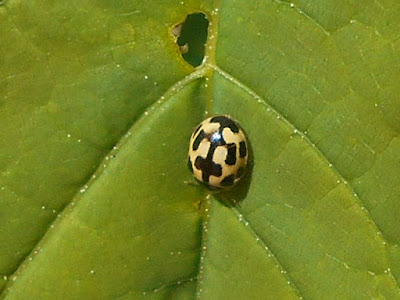Dandelions studded the grassy areas of the park. Fifty years ago I would have expected the flowers to be attracting dozens of not hundreds of insects. Today I saw just the one bee, and that didn't linger.
Even so, there were insects around in considerable numbers but the first creature to come to my attention was a mite. The Galium Gall Mite, Cecidophyes rouhollahi causes the tips of Goosegrass to become distorted, with thickened, twisted leaves. This is my first gall of the season (although I have found the remains of some from last year).
 |
These goosegrass leaves have been distorted by the Galium Gall Mite.
Stefen Hill Country Park. 20 April, 2019
|
A few days ago I found some Brassica Bugs, Eudema oleracea, on Hedge Garlic. Alliaria petiolata. I photographed some specimens but none of the pictures was satisfactory. Today I revisited the site in order to obtain a picture, but I was in for a surprise. No Brassica Bugs were found but instead around fifty Sloe Bugs, Dolycoris baccarum, were congregated on the plants.
 |
Sloe bugs were congregated on Hedge Garlic. Stefen Hill Pocket Park.
20 April, 2019
|
Many were mating and the gathering may have been the consequence of females releasing pheromones to attract the males. With black and white antennae and similarly coloured edges to the abdomen they are easily recognised. The pale tip to the scutellum is also distinctive though other bugs have a similar feature.
 |
| Many were in copula, as biologists often put it. |
Far more surprising was the presence of at least four Cinnamon Bugs, Corizus hyoscyami. I have mentioned these insects in previous blogs. Once rather rare and confined to sandy areas around the coast of southern Britain this species has, over the last couple of decades, enjoyed a remarkable expansion in range for reasons which are not obvious. Apparently from close up they smell of cinnamon.
 |
Cinnamon Bugs were present too, clearly also intent on pairing.
Stefen Hill Country Park. 20 April, 2019
|
A third bug, very common everywhere, was found on some dock leaves. The favoured plant was no surprise as it was a Dock Bug, Coreus marginatus. Again there were several specimens present and they too clearly planned a passionate affair.
 |
Dock Bugs are common on docks, but also their relatives such as
rhubarb. Stefen Hill Country Park. 20 April, 2019
|
The only other insect I photographed was a very common ladybird. We have several yellow and black ladybirds in Britain but this, the 16-spot Ladybird, Tytthaspis 16-guttata, (= Micraspis 16-punctata) is the commonest by a country mile (whatever that is). It feeds on mildews, often in grass tussocks. Not being dependent on aphids it is frequently active in winter.
 |
The 16-spot Ladybird is a mildew feeder but here is on a Norway Maple
leaf. Stefen Hill Pocket Park. 20 April, 2019
|
The numbers of species now recorded for the pocket park steadily rises and has now topped the 80 mark with some yet to be determined. The tiny beetle Bruchus loti is the latest addition to he list. It is common but easily overlooked. Perhaps the most interesting species recorded was the Red-girdled Mining Bee, Andrena labiata, a rather scarce insect.
No comments:
Post a Comment